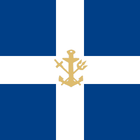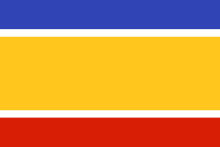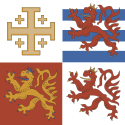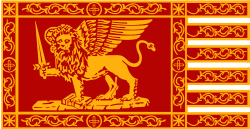Flag of Cyprus
 | |
| Use | National flag and ensign |
|---|---|
| Proportion | 2:3 |
| Adopted |
16 August 1960 (original design) 24 April 2006 (current version) |
| Design | An outline of the country of Cyprus above twin olive branches on a white field |
| Designed by | İsmet Güney |
 Variant flag of Republic of Cyprus | |
| Use | Naval Jack |

The national flag of Cyprus (Greek: σημαία της Κύπρου simea tis Kipru; Turkish: Kıbrıs bayrağı) came into use on 16 August 1960, under the Zurich and London Agreements, whereby a constitution was drafted and Cyprus was proclaimed an independent state. The flag was designed by art teacher İsmet Güney.[1] The flag deliberately chose peaceful and neutral symbols in an attempt to indicate harmony between the rival Greek and Turkish communities, an ideal that has not yet been realized. In 1963 Turkish Cypriot and Greek Cypriot communities separated because of Cypriot intercommunal violence.
The state flag features the shape of the entirety of the island, with two olive branches below (a symbol of peace) on white (another symbol of peace). The olive branches signify peace between the Turks and Greeks. The map on the flag is a copper-orange colour, symbolising the large deposits of copper ore on the island, from which it may have received its name.
The flag is notable for not being particularly liked by either Greek or Turkish Cypriots; former President Glafcos Clerides described it as "the most innocent flag in the world", because "no one died for it".[2]
Creation
Before the flag of Cyprus was introduced, the flags of Greece and Turkey were used. The current flag was created as the result of a design competition in 1960. Under the constitution, the flag should not include either blue or red colours (the colours of the flag of Greece and the flag of Turkey), nor portray a cross or a crescent. All participants deliberately avoided use of these four elements in an attempt to make the flag "neutral".
The winning design was based on a proposal by İsmet Güney, a Turkish Cypriot art teacher.[1] The design was chosen by Makarios III, the first President of the Republic, with the consent of Fazil Küçük, the first Vice-President.
Under the constitution of Cyprus, the flag of Cyprus may be flown by state institutions, public corporations, and citizens of the country. Private citizens may fly the flag of Cyprus alongside either the Greek flag, the Turkish flag, or both.
Despite the attempt at a neutral design to promote unity amongst the constituent communities, this flag is most often used only by the Greek Cypriots, since it is associated by the Turkish Cypriots with the Greek-dominated Republic of Cyprus. Following the Turkish invasion of Cyprus and the establishment of the self-declared Turkish Republic of Northern Cyprus, Turkish-Cypriots use the Flag of Northern Cyprus.
In the design of August 1960, the colour of the map is copper (Pantone 144-C). Both the crest and the two olive-tree leaves are olive green (Pantone 336-C). The background is white with the 3:5 ratio. In April 2006 the design was updated, the shape of the olive branches were slightly altered, its color was changed to Pantone 574, The copper color of the map was changed to Pantone 1385 and the ratio was changed to 3:2.[3][4]
Flags produced on Cyprus often differ from the original specifications, both regarding the size of the map and the colours used. The government announced in October 2005, that it would take steps to "start from scratch" and assure that only flags complying with the official specifications would be produced.[5]
Proposed national flag

Under the terms of the publicly-rejected referendum Annan Plan for Cyprus, a United Nations proposal to settle the Cyprus dispute, a new national flag would have been adopted by a reconstituted confederal republic of Cyprus. Unlike the current official flag, this version consciously incorporates colours representing Greece (blue) and Turkey (red) alongside a large copper-yellow band for Cyprus; the heraldic blazon is per fess Azure and Gules, a Spanish fess Or fimbriated Argent. It is possible that any future Cyprus settlement will include the adoption of a new flag.
Gallery
 Flag of the Kingdom of Cyprus (15th century)
Flag of the Kingdom of Cyprus (15th century) Flag of the Republic of Venice (1489–1571)
Flag of the Republic of Venice (1489–1571).svg.png) First flag of Cyprus under British colonial rule (1881–1922)
First flag of Cyprus under British colonial rule (1881–1922).svg.png) Last flag of Cyprus under British colonial rule (1922–1960)
Last flag of Cyprus under British colonial rule (1922–1960).svg.png) Version of the flag used from 6 April to 16 August 1960.
Version of the flag used from 6 April to 16 August 1960..svg.png) Version of the flag used from 16 August 1960 to 24 April 2006.
Version of the flag used from 16 August 1960 to 24 April 2006. Version of the flag used since 24 April 2006.
Version of the flag used since 24 April 2006.
See also
References
- 1 2 Evripidou, Stefanos (25 June 2009). "Cyprus flag designer dies". Cyprus Mail. Archived from the original on 26 June 2009. Retrieved 11 July 2009.
- ↑ Cemal Yorgancioglu, Nationalisms and the International Conjuncture: the case of Cyprus, 1945-1964
- ↑ "Presidency of the Republic of Cyprus - The Flag". www.presidency.gov.cy. Retrieved 29 November 2017.
- ↑ cahoon, ben. "Cyprus". www.worldstatesmen.org. Retrieved 29 November 2017.
- ↑ "Archived copy". Archived from the original on 2007-09-30. Retrieved 2005-10-23.
External links
| Wikimedia Commons has media related to Flags of Cyprus. |
- Cyprus at Flags of the World
- Flags in Cyprus
- Cyprus Flag and Emblem - Cyprus Government Web Portal
